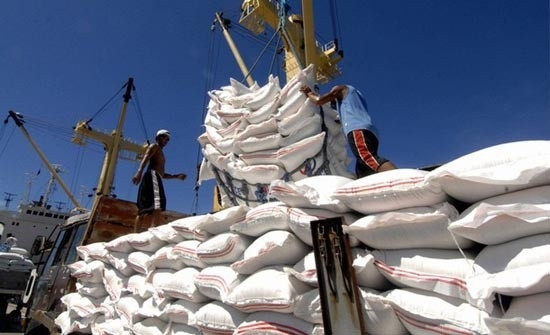 Vietnam earns 1.71 billion USD from exporting nearly 3.5 million tonnes of rice in the first half of this year. (Photo: doanhnhansaigon.vn)
Vietnam earns 1.71 billion USD from exporting nearly 3.5 million tonnes of rice in the first half of this year. (Photo: doanhnhansaigon.vn)Hanoi (VNS/VNA) - Rice quotas for Vietnam under theEVFTA are expected to push Vietnam’s rice exports up from the second half ofthis year, according to the Ministry of Industry and Trade (MoIT).
Under the Vietnam-EU Free Trade Agreement (EVFTA) effectivefrom August 1, the EU pledges to provide an annual rice quota of 80,000 tonnesto Vietnam and completely liberalise trade in broken rice. After three to fiveyears, tariffs on rice products will be slashed to zero percent.
Tran Thanh Hai, deputy director of MoIT’s Import and ExportDepartment, said that in 2019, Vietnam saw modest earnings of 10.7 million USDfrom rice exports to the EU because of high import tariffs in this market.
At present, the EU’s import tariffs for Vietnamese rice is175 EUR (198 USD) per tonne of milled rice, 65 EUR per tonne of broken rice and211 EUR per tonne of paddy.
"The rice quotas of 80,000 tonnes to Vietnam accordingto the commitments in the EVFTA is an opportunity for Vietnam to enhance itsrice exports to this market, which has annual demand of about 2.5 milliontonnes of rice," Hai told the Hai Quan (Customs) newspaper.
Meanwhile, the EU also sets a range of conditions for thosequotas such as origin certificates on Vietnamese rice. The rice exported to EUmust have authenticity certificates issued by Vietnamese authorities.
To take advantage, the Ministry of Agriculture and RuralDevelopment (MARD) and the MoIT are compiling a draft decree guiding the registrationprocess for certification of rice categories exported to the EU to submit tothe Government for approval.
According to this draft, eligible rice varieties exported tothe EU must meet Vietnam’s technical standards and regulations on quality,region cultivating rice varieties, and processes of harvesting, preserving,grinding, milling and packaging rice.
Pham Thai Binh, general director of the Trung An High-techAgriculture Joint Stock Company in Can Tho City, said Vietnamese rice reachingthose requirements to enter the EU with low tariffs would help Vietnam increaseits rice exports in the future.
"When the tariff for Vietnamese rice is reduced to zeropercent, it gives local rice products more advantages in competing with ricefrom Cambodia and other countries in the EU market," Bình said.
The agriculture sector expects to significantly increaseexports of many key products until 2025 thanks to the EVFTA, such as rice (up65 percent), sugar (8 percent), pork (4 percent), forest products (3 percent),and cattle and poultry meat (4 percent).
However, those products must overcome many trade barriers ofthe EU, such as technical barriers on origin, product quality and intellectualproperty protection.
Therefore, experts said that local farmers and businesses inthe agriculture sector have to improve production capacity and product quality,find export markets and build brands for agricultural products.
In the long term, strict regulations on quality standards forexported Vietnamese agricultural products, including rice, would force theagriculture sector to undertake comprehensive restructuring in production andbusiness.
According to MARD, Vietnam earned 1.71 billion USD fromexporting nearly 3.5 million tonnes of rice in the first half of this year, up17.9 percent in value and 4.4 percent in volume year-on-year. In June alone,409,000 tonnes of rice worth 207 million USD was shipped abroad.
The Philippines was the top buyer between January and May,importing 1.3 million tonnes of Vietnamese rice worth 598.6 million USD, or 40percent of total rice exports. They were up 23 percent in volume and 42 percentin value from a year earlier.
During the first five months, markets to which the value ofrice exports enjoyed the strongest year-on-year growth were Senegal(18.3-fold), Indonesia (2.9-fold), and China (2.3-fold).
Meanwhile, rice export prices increased 13 percent from thesame period last year to average 485 USD per tonne./.





























